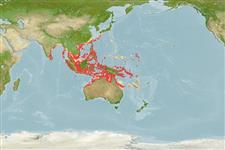Environment: milieu / climate zone / depth range / distribution range
Écologie
marin récifal; non migrateur; profondeur 3 - 60 m (Ref. 90102). Tropical; 32°N - 23°S, 77°E - 169°E
Indo-Pacific: Ryukyu Islands to Malaysia and Indonesia to Solomon Islands, south to Australia.
Taille / Poids / Âge
Maturity: Lm ? range ? - ? cm
Max length : 46.0 cm TL mâle / non sexé; (Ref. 2334)
Épines dorsales (Total) : 13 - 14; Rayons mous dorsaux (Total) : 18 - 23; Épines anales: 3; Rayons mous anaux: 18 - 19.
Juveniles prefer sheltered inner reefs while adults occur in areas of rich coral growth and high vertical relief of lagoon and seaward reefs. Adults semi-silty coastal to about 50 m depth, often seen in pairs (Ref. 48636). Occur solitary or mostly in pairs, are very elusive. Emits loud grunting sounds when harassed. Only the young make excellent aquarium fish (Ref. 4859).
Life cycle and mating behavior
Maturities | Reproduction | Spawnings | Egg(s) | Fecundities | Larves
Randall, J.E., G.R. Allen and R.C. Steene, 1990. Fishes of the Great Barrier Reef and Coral Sea. University of Hawaii Press, Honolulu, Hawaii. 506 p. (Ref. 2334)
Statut dans la liste rouge de l'IUCN (Ref. 130435)
Menace pour l'homme
Harmless
Utilisations par l'homme
Pêcheries: pêcheries vivrières; Aquarium: Commercial
Outils
Articles particuliers
Télécharger en XML
Sources Internet
Estimates based on models
Preferred temperature (Ref.
123201): 25.5 - 29, mean 28.1 °C (based on 764 cells).
Phylogenetic diversity index (Ref.
82804): PD
50 = 0.5001 [Uniqueness, from 0.5 = low to 2.0 = high].
Bayesian length-weight: a=0.03802 (0.01932 - 0.07482), b=2.86 (2.69 - 3.03), in cm total length, based on LWR estimates for this species & Genus-body shape (Ref.
93245).
Niveau trophique (Ref.
69278): 2.6 ±0.00 se; based on food items.
Résilience (Ref.
120179): Faible, temps minimum de doublement de population : 4,5 à 14 années (Preliminary K or Fecundity.).
Fishing Vulnerability (Ref.
59153): Moderate vulnerability (36 of 100).
Nutrients (Ref.
124155): Calcium = 37.6 [18.5, 64.0] mg/100g; Iron = 0.5 [0.3, 0.8] mg/100g; Protein = 18.2 [16.9, 19.4] %; Omega3 = 0.0896 [, ] g/100g; Selenium = 38.1 [20.1, 73.9] μg/100g; VitaminA = 53.4 [12.9, 206.6] μg/100g; Zinc = 1.28 [0.88, 1.84] mg/100g (wet weight);
